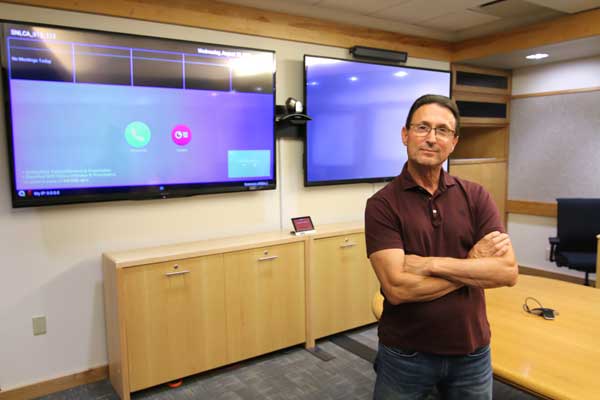Digital tools prove to be a necessity during pandemic

The COVID-19 pandemic and resulting stay-at-home orders have led to significant changes to the way people work. Expanding the use of videoconferencing and other digital collaboration tools was critical for Sandia to continue to meet mission deliverables — and that has meant explosive growth for the Integrated Video Solutions team.
With a rise in telecommuting and virtual work for much of the Labs’ workforce, the videoconferencing team worked tirelessly to ensure everyone had an effective way to communicate while working remotely, as well as to provide new options so that workforce members could maintain social distancing when returning to work.
“It’s not widely known, but Division 8000 is responsible for videoconferencing throughout all of Sandia,” said Andy McIlroy, associate labs director for Integrated Security Solutions. “Last March we went from ‘Videoconferencing is nice to have’ to ‘I can’t live my day without it.’”
Andy called the overnight change in demand for video communications tools “daunting.”
Rise in demand
Marc Campanozzi, a member of the Integrated Video Solutions team, quantified the increase in demand for videoconferencing services.
“Before COVID, our team was focused on installing and maintaining conference rooms,” Marc said. “We supported a large-group meeting here or there, but it wasn’t our primary concentration.”
In March 2020, the team quickly shifted to providing online videoconferencing support and today helps stream and record more than 50 large-group meetings on Skype and Microsoft Teams each month — meetings such as health education seminars, division town halls, Labs-wide all-hands meetings, intern events and more.
In addition to large-group meetings, the use of Skype conferences and Microsoft Teams for smaller one-on-one collaborations, department meetings, hiring interviews or external presentations has also grown substantially, rising to an average of 138,000 virtual meetings each month.
“We quip that Skype was a savior during COVID. But the fact is that without it, we would have been at a standstill,” Marc said. “Our team was proud to be able to do our part to keep the mission moving forward in the face of adversity.”
“We had some issues early on, but it is remarkable how fast the team was able to respond — really within just a few days,” Andy said. “Our videoconferencing team, as well as the networking team across the Laboratories, really stepped up to make sure that we had the capacity to deal with this. That was huge.”
Innovative teaming
Throughout the transition to remote work, the videoconferencing team worked closely with many partnering organizations from across the Labs.
Central to the operating strategy for Integrated Security Solutions is the Integrated Service Delivery model, which emphasizes being proactive, thinking critically, taking personal accountability and teaming for mission success. Embracing this mindset, the Integrated Video Solutions team collaborated with Enterprise Collaboration Services, Creative Services, Digital Media Operations and other partners to create innovative solutions.
“We were all teaming to provide new and innovative ways for large meetings and other communication to happen online,” Marc said, explaining how the partners resolved urgent issues by pooling resources, cross-training staff and combining the functionality of video-streaming platforms with existing equipment in on-site auditoriums. This allowed them to increase participant capacity, more efficiently record meetings and archive videos for later viewing.
“While the pandemic caused a lot of teams to be more separated and even isolated from one another, in a way it brought our team closer, encouraging us to work with other organizations to solve new problems together,” Marc said.
The future of videoconferencing
The Integrated Video Solutions team has also been preparing for an eventual return to increased on-site work. Because of the Labs’ maximum telework posture, many of the 300 on-site conference rooms have been unoccupied. The team took advantage of the opportunity to transition these collaboration spaces: adding more modern videoconference tools for improved user experience, updating software and hardware and expanding on-site classified options.
“We don’t know entirely what the future will look like or what role videoconferencing will play moving forward,” Marc said, noting that supporting a hybrid workforce will present new challenges. “Things keep on changing, and we’re learning more about the virtual meeting space, trying to make it better. But we certainly don’t expect to see an end to video calls. If anything, videoconferencing is going to be a substantial component of meetings, if not a complete necessity.”